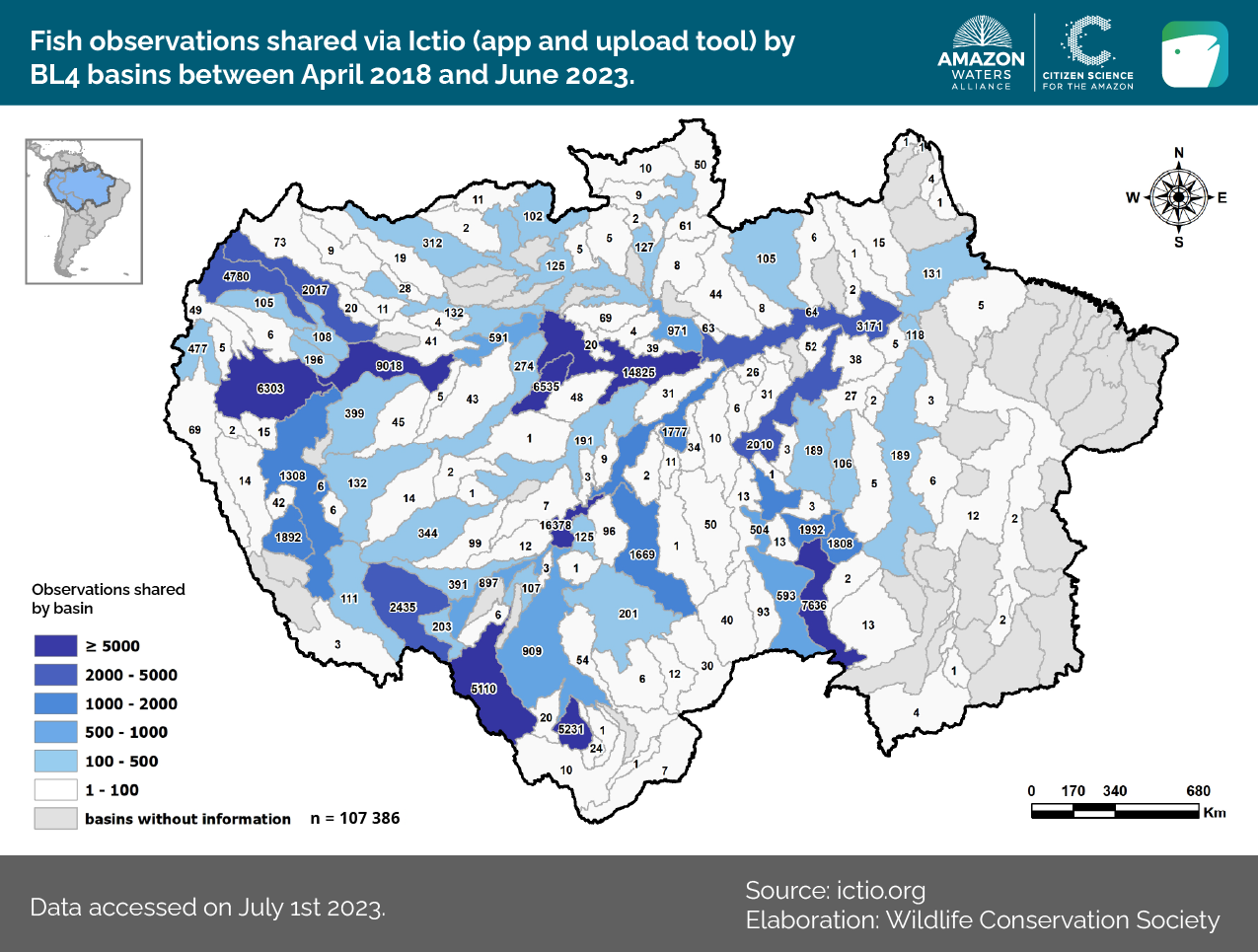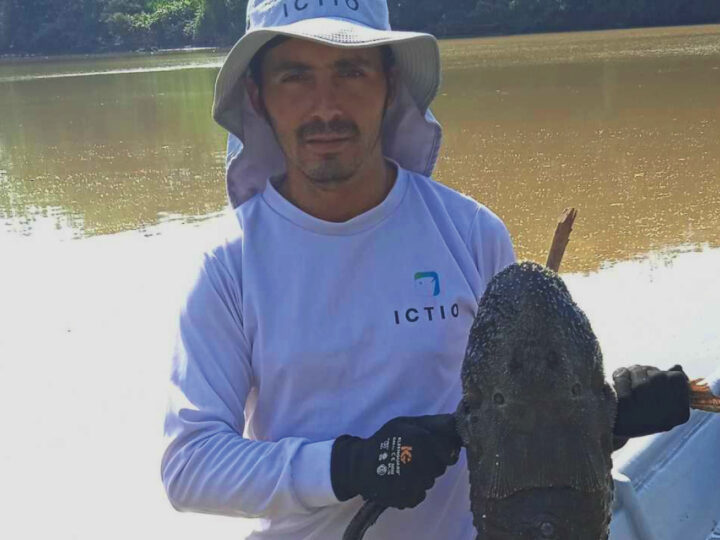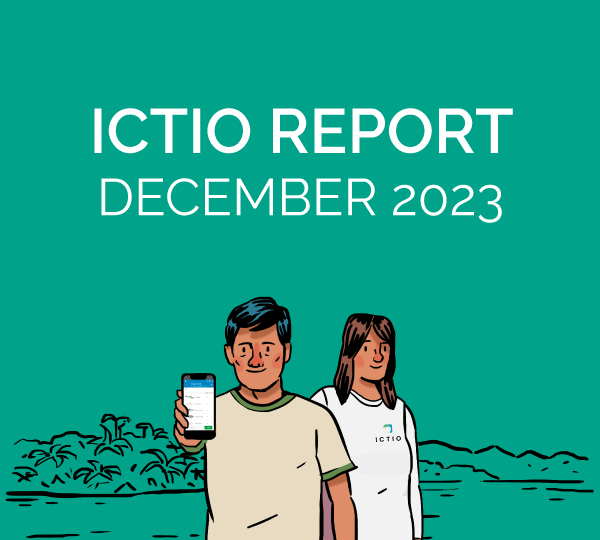
Ictio celebrates five years since its launch with 107,386 observations of 119 fish species/species groups shared by 693 citizen scientists and organizations (Figure 1).

Figure 1 – Between the launch of Ictio in April 2018 and 30 June 2023, 693 people and organizations recorded a total of 107,386 fish observations in 61,829 lists (or fishing events) in 153 (77%) of the 199 level 4 sub-basins of the Amazon.
Fish observations can be recorded through the Ictio application (download link); and through the ictio.org webpage. All new observations from April to June 2023 were recorded (5% increase in number of observations) through the app (Figure 2).

Figure 2 – By 30 June 2023, 680 users shared a total of 21,250 fish observations across 13,092 lists (or fishing events) through the Ictio app.
Fish observations were recorded in 153 of the 199 Level 4 (BL4) sub-basins of the Amazon (i.e., 77%) (learn more about the basin classification used by Ictio in Venticinque et al., 2016 – ‘New Geographic Information System (GIS) on rivers and basins for the conservation of aquatic ecosystems in the Amazon’). The ‘Madeira – above Jamari’ sub-basin contains the highest number of observations with 16,378. In this quarter, between April and June 2023, we had a notable increase in the number of observations in the ‘Arinos’ sub-basin of the Tapajós River, located in Mato Grosso, Brazil; in the ‘Morona’ sub-basin of the Marañón River, located between Peru and Ecuador; and in the ‘Tambopata’ sub-basin of the Madeira River, located near the city of Puerto Maldonado, Peru (Figure 3).

Figure 3 – Increases (%) in the number of observations recorded in the Ictio app and upload tool between April and June 2023.
With Ictio, users can choose from 131 species or species groups. When species are not available in the database, users can also choose the option ‘Other fish’ (‘Fish sp’). In these cases, users are encouraged to provide additional comments and to take a picture to further aid identification and potential inclusion in future versions of the app.
Of the species recorded in Ictio, the jaraqui (Semaprochilodus insignis) remains the common with 8,564 observations, followed by ‘Other fish’ with 7,412 observations, and the tambaqui (Colossoma macropomum) with 6,676 observations. Additional information, including occurrence maps of two priority migratory species (i.e., Brachyplatystoma rousseauxii, Prochilodus nigricans) and the number of observations of the 10 most common species, is included in the supplementary material at the end of this report.
A VIBRANT COMMUNITY
In the five years since its launch, 693 people and organizations have used Ictio to sharefish observations across the Amazon. Between April and June 2023 there was an increase of over 3% in the number of users of the platform. The app user with the highest number of observations has made 815 observations in the Putumayo-Içá region (Colombia).
In addition to the app, 22 people and organizations have used the web upload platform to share fish observations. Most of these users are member organizations of the Amazon Waters Alliance sharing information from their monitoring and research activities. By using the upload tool organizations have the opportunity to share recent and historical information, increasing the span of time of fish observations included in the Ictio database.
CITIZEN SCIENCE CONTRIBUTING TO ACADEMIC SCIENCE
Recently published, the scientific note ‘Nuevos registros por cientificos ciudadanos de Acanthicus hystrix Agassiz, 1829 (Siluriformes: Loricariidae) en la Amazonia ecuatoriana‘, by Fernando Anaguano (WCS Ecuador) and collaborators, highlights the relevance of citizen science for the conservation of fisheries resources in the Amazon. Using data from the Ictio app, the study records the first observation of Acanthicus hysterix, a species of armored catfish (or carachama in Spanish), in the Ecuadorian Amazon, expanding the species known range. Additionally, using local fisheries information, the study also notes the commercial importance of the species in the region. In partnership with local fishers, the authors also collected and deposited the first individual of the species in an Ecuadorian museum.
Congratulations to Fernando and collaborators, all of us in the Ictio community are proud of this contribution to the knowledge of Amazonian fishes! Below, we share one of the photographs that is part of the work and was shared via the Ictio app by Jonathan Espinoza, from Asociación de Pescadores Artesanales Río Napo, and co-author of the paper (Figure 4 – ML514871211 Fish sp. Macaulay Library).

Figure 4 – Acanthicus hystrix (or carachama) caught in the Napo River, Ecuador. This observation was uploaded via the Ictio app and was the first of the species in the Ecuadorian Amazon. Credit: Jonathan Espinoza/Macaulay Library at the Cornell Lab (ML514871211).
The figures presented in this note and other data products are available below.
GLOSSARY
Checklists: Lists of fish caught in a fishing event.
BL4 Basins: Basin level 4 is the scale that delineates all tributary sub-basins between 10,000 km² and 100,000 km².
Observations: Records of species/groups of fish species caught in the Amazon Basin.
Users: Amazonian citizens using the ICTIO application or platform, consisting mainly of local and indigenous peoples, individual fishers, management groups, associations of fishermen, and scientists.

This note is made possible thanks to the support of the Gordon and Betty Moore Foundation and of the people of the United States through the United States Agency for International Development. The content is the responsibility of the Wildlife Conservation Society and does not necessarily reflect the views of the Moore Foundation, USAID, or the United States Government.





